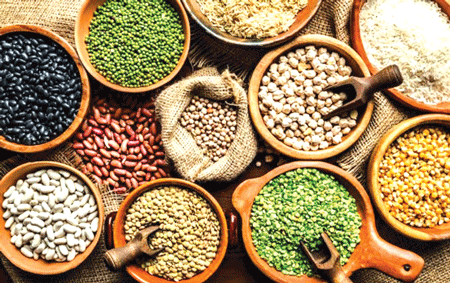
Seed Savers Network; saving seeds for generational use
Seed saving is a golden idea that has not been fully embraced by Kenyan farmers. In 2009, a group of farmers in GilGil hatched the idea of preserving seeds. This was occasioned by lack of diverse seeds in the market and agro-shops. For instance in their course of cultivation, they discovered that out of 100 varieties of beans, they could only find 4 varieties for planting while the rest could not be accounted for. The baffling part of the story was, while traversing across villages, farmers could recall and describe different characteristics of beans but could not understand how they disappeared. Due to their families’ nutritional needs and for future generational use, they birthed Seed Savers Network (SSN) which is being chaperoned by Daniel Wanjama as the Director.
The main door leading into the seed bank has been beautifully decorated with a variety of seeds including red beans, white rice, green grams as well as red and brown sorghum. Inside the seed bank; a one storey house made of mud and refurbished materials, a variety of maize, legume, vegetable and pumpkin seeds are hanged on the wall while others are stored in small containers.
SSN began with 50 farmers at the beginning, but today the network has morphed to 66,000 farmers organized in groups of 20 farmers and spread out across the country. Seeds are the basis of agriculture, carriers of the genetic makeup of plants and the soul of food systems.
In Kenya, over 80% of seeds used by smallholder farmers are sourced from ‘informal’, or farmer-managed seed systems. Farmers have been managing seed and propagating plant materials through on-farm conservation, maintenance, and selection for diversity. They save, re-use, exchange, and sell seeds amongst family, neighbors, and communities to produce the bulk of their food. However, smallholder farmers increasing face difficulties in accessing, using, and multiplying seeds. Farmer-managed seed systems are under pressure from the commodification and commercialization of seeds through exclusive intellectual property rights, such as patents and breeders’ rights. Free and open access to seeds is key to sustaining and strengthening farmer-managed seed systems and improving food security.
According to Julia Kamau, Head of Programs at Seed Savers Network, the organization is a farmer led initiative dedicated to promoting food and seed sovereignty. It safeguards plant genetic materials through on-farm seed saving, community seed banks, and field gene banks. “The gist of seed saving is conservation. It does not stand alone; it goes hand in hand with production work. With production, we are doing agro-ecology kind of farming where chemicals and pesticides are not allowed. We are also have training center where farmers come and practically learn on how to carry out the whole process of seed production,” she said.
Seed saving is a whole process that entails re-generation or growing the seed and marking the seed which will be extracted at the end. “First, SSN carry out diversity assessment and store most of the neglected under-utilized species but unfortunately they are in small quantities and we require them in big quantities for them to be sustainable for a long time thus where regeneration comes in. For conservation, we don’t store seeds on the shelves for a long time, but a maximum of three years, thereafter we test their viability before we re-generated them again. Currently we are re-generating 5 types of crops; sorghum, pigeon peas, cowpeas and millet for long time conservation in a freezer at -20 degrees,’’ opined Mary Wambui, Program officer at SSN.
The first step for seeds storage in the seed bank, is to check on the moisture content to confirm if they are dry enough to a prescribed percentage depending on the variety. A germination test is done to check on the viability of the seeds. The germination rate should be 85% and above for the seeds to be banked. The day the seed are stored in the seed bank is then recorded.
“At SSN we use a farmer to farmer extension model to train farmers on agro-ecology and facilitate the spread and adoption of seed saving, regenerative farming practices, and food sovereignty ideals. This capacity-building model leverages on farmer’s traditional knowledge and information and builds on local conditions and practices already known to farmers. Contrary to a top-down approach, this is inclusive, low-cost and has a multiplier effect that ensures successful introduction of agro-ecological practices in rural areas to ensure sustainable livelihoods,” Julia Kamau, Head of Programs at Seed Savers Network stated
“Some of the Kenyan laws on seed prohibit exchange within farmers. One of the main workforce of SSN is to work on changing that policy. For instance there is a case in court where farmers have sued the government, in challenging the seed and variety Act of 2012, which stipulates that sharing and exchange of seeds is defined as selling, which is illegal. But in the Kenya constitution it is stipulated that it has given farmers cultural right to celebrate culture and seed exchange which classified as a cultural practice. This is what we want to deem the Act as unconstitutional because The Constitution is supreme than the Act,” she explained on the biggest challenge they have encountered over the years.

